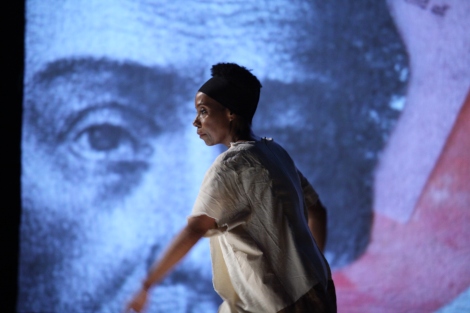
Germaine Ingram in Where Heaven’s Dew Divides. (Photo: Nathea Lee)
No place is a place until things that have happened in it are remembered in history, ballads, yarns, legends, or monuments… No place is a place until it has had a poet.”
– Wallace Stegner
Ellen Gerdes describes exploring Wesley Hymns to perform as part of Where Heaven’s Dew Divides:
And with Dave, I went into his apartment, and he was improvising on the piano. And there was this one Wesley hymn that we both thought, “Oh, that’s so beautiful.” And by the time I sang it, we had slowed it down a lot, and it was just sort of natural that I sing it very, very slowly… I felt that our connection as musicians mattered a lot… And I remember turning to Germaine and saying, “Does it matter that you can’t understand the words at all – it’s so slow?” And she said, “I’m not listening to the words.” You know, so it was just sort of us figuring out what that hymn wanted to be for us… And so I started connecting through the melody, even if it’s not my concept of god. I found a lot inner calm around the melodies that we had found. So that was my entrance that way.
Germaine Ingram describes the power of place to witness many events over time, and to carry forth the residuals of those experiences within itself:
I guess, especially when you’re talking about a historic site, the site speaks for itself. And the role of the artist is to create opportunities to see into, and see behind the façade. So what [Peter DiMuro] was trying to do was help us develop tools for investigating the space in a way that reveals the narratives – the witnessing – that the site represents. For instance, just the surfaces on the staircase: the way that they’re worn away. What does that represent in terms of the number of people who have traveled that space? Who were the people who traveled that space? Did the people who traveled the space in the back, were those different than the people who traveled the space in the front?
We spent some time doing some exploration of the grounds outside the Johnson House, and creating little individual scores that responded to the landscape, the relationship to the house, the relationship to the buildings around it, the relationship to Germantown Avenue running right next to it. And the juxtaposition of this busily traveled city street and this historic house that goes back to the mid-1700s, and has had multiple narratives related to the inhabitants: four generations of Friends; generations of abolitionists; it being a stop on the Underground Railroad; it being the headquarters of a progressive women’s group that was really important in creating avenues for public education and addressing the needs of the poor and community development in their Germantown neighborhood. So it was a question of how the house tells those stories. Or how the house has served as a witness, and how we as artists can ask the questions of the house that reveals its role as witness to those important and quotidian events.
